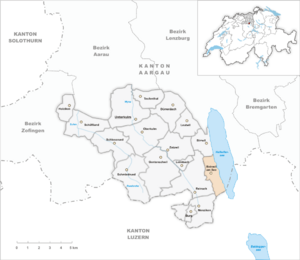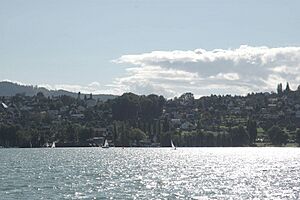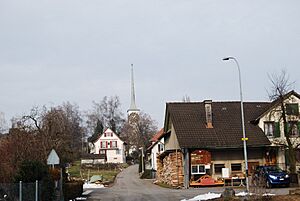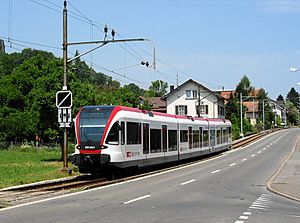Beinwil am See facts for kids
Quick facts for kids
Beinwil am See
|
||
|---|---|---|
 |
||
|
||
| Country | Switzerland | |
| Canton | Aargau | |
| District | Kulm | |
| Area | ||
| • Total | 3.83 km2 (1.48 sq mi) | |
| Elevation | 520 m (1,710 ft) | |
| Population
(Dec 2020 )
|
||
| • Total | 3,418 | |
| • Density | 892.4/km2 (2,311/sq mi) | |
| Postal code |
5712
|
|
| Surrounded by | Aesch (LU), Beromünster (LU), Birrwil, Fahrwangen, Meisterschwanden, Menziken, Reinach | |
Beinwil am See is a town in Switzerland. It is located in the Aargau canton, within the Kulm district. As of December 2020, about 3,418 people live here.
This town has a long and interesting history. People have lived here since the Neolithic era, which was a very long time ago! Beinwil am See used to be a farming village. Over time, it grew into a busy industrial center. Today, the town makes many things. These include cigars, candy, glass, mirrors, and electric motors. They also produce electronics and special tools for testing building materials.
Beinwil am See covers an area of 3.84 square kilometers. It is located in the Seetal valley. This valley is right next to the beautiful Hallwilersee. Most people in Beinwil am See speak German. Some also speak Albanian or Italian. The town is part of a UNESCO World Heritage Site. This site protects ancient stilt houses found around the Alps. You can travel to Beinwil am See by train. Local trains connect it to Lucerne in the south and Lenzburg in the north.
Contents
History of Beinwil am See
People have lived in or near Beinwil for thousands of years. We have found traces of ancient settlements. These include homes from the Stone Age (Neolithic) and the Hallstatt culture. There are also signs of Roman and Alamanni people.
The first time Beinwil am See was written about was in 1036. It was called Beinwile back then. A noble family, the von Beinwils, lived here. They were important in the area. Their castle is now gone. Later, the town came under the control of different groups. In 1520, it was sold to Bern.
In 1415, Bern took over the Aargau region. Beinwil was part of this area. It stayed under Bern's rule until 1798. That's when the French took over and created the Helvetic Republic. After this republic ended in 1803, Beinwil became part of the new Canton of Aargau.
Originally, Beinwil belonged to a church area called Pfeffikon. It had its own small chapel. In 1528, the town became Protestant during the Reformation. It joined the church in Reinach. Beinwil got its own church area in 1932. A new local church was built in 1935. Later, in 1964, a Roman Catholic church was built for the growing community.
In the 1700s, the cotton industry here declined. But the tobacco industry grew. The first tobacco factory opened in 1841. Today, Beinwil am See is known for making many different products. These include cigars, candy, glass, mirrors, and electric motors. They also make electronics and special tools for testing building materials. Many people who live here also work in other towns. About 55% of workers come into Beinwil. About 59% of workers from Beinwil go to other towns.
Geography and Nature
Beinwil am See is located in the Seetal valley. It sits right on the western edge of Hallwilersee. The town was once mainly farms. Now, it is a busy industrial center.
The town covers about 3.84 square kilometers. Almost half of this land, about 47.9%, is used for farming. This includes fields for crops and pastures for animals. About 19.8% of the area is covered by forests. The rest of the land, about 31.8%, has buildings and roads. A small part, 0.3%, is rivers or lakes.
Town Symbol: Coat of Arms
The coat of arms for Beinwil am See is simple and unique. It shows a blue triangle shape. This shape starts from the bottom right corner and points upwards to the left. The background is silver.
People and Population
Beinwil am See has a population of about 3,418 people. About 9.7% of the people living here are from other countries. Most people, about 94.9%, speak German. Albanian is the second most common language, spoken by 1.4% of the population. Italian is third, spoken by 0.7%.
The town has a mix of ages. About 8.4% of the population are children aged 0-9. Teenagers aged 10-19 make up about 11.9%. Adults aged 20-59 make up a large part of the population. Older adults, aged 60 and above, make up about 22.8% of the population.
Many homes in Beinwil am See are owned by the people who live in them. About 56.7% of households own their homes. In 2008, there were 1,334 homes and apartments in the town. Most of these, 666, were single-family homes.
In the 2007 national election, the SVP was the most popular party. They received 37.6% of the votes. The SP and the FDP were also popular.
Education is important here. About 79% of adults aged 25 to 64 have finished high school or gone on to higher education. In the 2008/2009 school year, 196 students attended primary school. Another 107 students attended secondary school in the town.
Here's how the population has changed over the years:
| Historical population | ||
|---|---|---|
| Year | Pop. | ±% |
| 1850 | 1,544 | — |
| 1900 | 1,831 | +18.6% |
| 1950 | 2,271 | +24.0% |
| 2000 | 2,581 | +13.7% |
Important Heritage Sites
Beinwil am See is home to very old pile-dwelling settlements. These are ancient homes built on stilts, often over water. They are part of the Prehistoric Pile dwellings around the Alps UNESCO World Heritage Site. This means they are very important and protected by the world. One specific site, called Ägelmoos, is from the Bronze Age. It is listed as a very important Swiss heritage site.
Economy and Jobs
In 2007, the unemployment rate in Beinwil am See was low, at 1.36%. This means most people who wanted jobs had them.
- About 49 people work in the primary sector. This means jobs like farming.
- About 210 people work in the secondary sector. This includes manufacturing and factories.
- About 460 people work in the tertiary sector. This includes jobs in services, like shops and offices.
In 2000, 1,251 workers lived in Beinwil am See. Many of them, about 71.5%, traveled outside the town for work. At the same time, 421 people came into Beinwil am See for their jobs. Most people, 52.4%, used a private car to get to work. About 10.4% used public transportation.
Religion in Beinwil
Based on the 2000 census:
- About 21.2% of the people were Roman Catholic.
- About 61.1% belonged to the Swiss Reformed Church.
- A very small number, about 0.12%, belonged to the Christian Catholic faith.
Getting Around: Transportation
Beinwil am See used to have a train service to Beromünster. This service was replaced by a bus. However, the Seetal railway line is still very popular. This train line goes from Beinwil am See to Luzern in the south and Lenzburg in the north. It has been updated and is used a lot by people.
See also
 In Spanish: Beinwil am See para niños
In Spanish: Beinwil am See para niños








